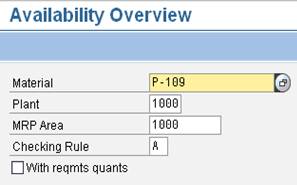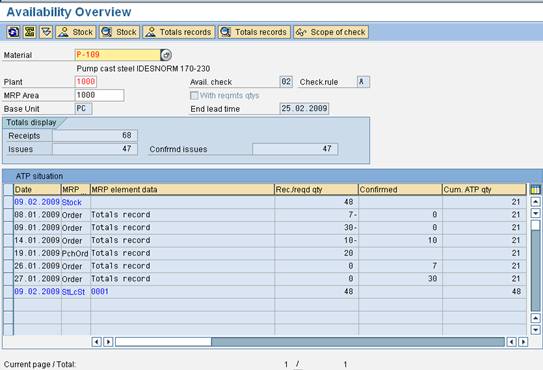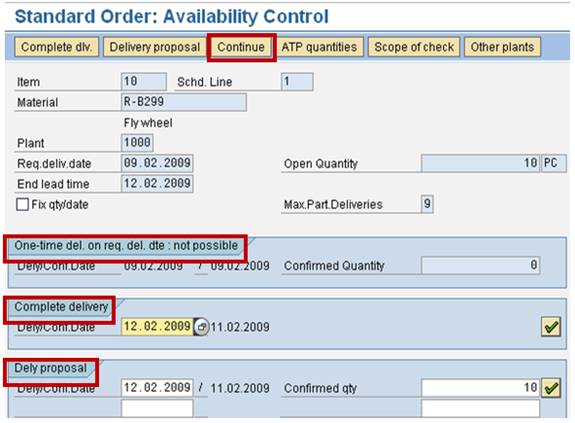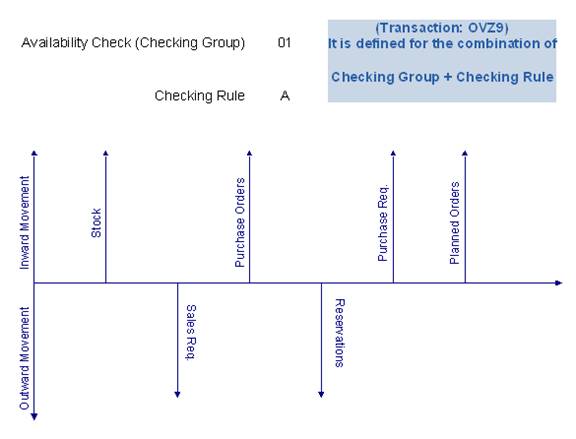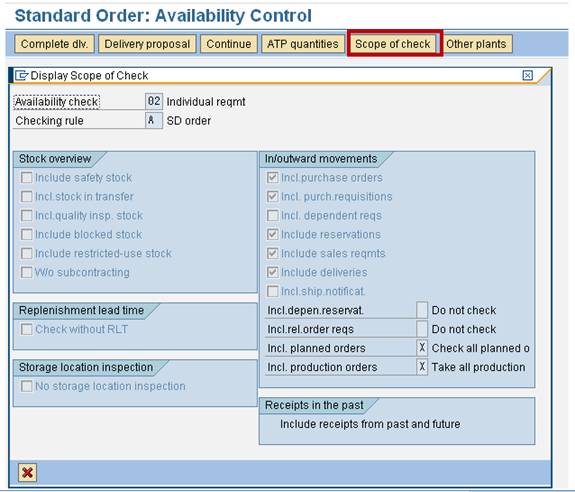点击此处--->
 群内免费提供SAP练习系统(在群公告中)
群内免费提供SAP练习系统(在群公告中)
加入QQ群:457200227(SAP S4 HANA技术交流) 群内免费提供SAP练习系统(在群公告中)
One short note before we start off the subject: Availability refers to the projections of future material stock availability based on the rules we define. It is not directly related to the actual stock. I have seen people confusing availablity with stock situation in MMBE. These are different things. As we will see, it is seen from CO09 according to the applicable Checking Rule. Also it is not directly related to Material Reservations, though we can see reserved materials in CO09.
What do we need to know?
Dates:-
Order Date – Date on which the sales order is entered. System proposes the current date by default.
Material Availability Date – The date on which the material must be available. On the material availability date, the vendor must start the activities relevant for delivery, such as picking and packing the goods. The material availability date must be sufficiently early enough so that the goods are prepared by the loading date.
Transportation Planning Date – We must arrange transportation by this date, so that the delivery can be sent to the customer. The date from which the organization of goods transport must begin. The transportation planning date must be selected early enough so that the transport is available on the loading date to load the goods.
Loading Date – Picking and packing must be completed by this date so that the goods are ready for loading.
Goods Issue Date – Goods must physically leave the shipping point by this date. The date on which the goods must leave the company to arrive at the customer location in time.
Delivery Date – Customer should receive delivery of the goods by this date. The date on which goods are to arrive at the customer’s premises. Example: The delivery date can be the delivery date requested by the customer (desired delivery date) or the date confirmed in the vendor’s order acknowledgment or shipping confirmation (confirmed or acknowledged delivery date).
Times:-
Pick/Pack Time – Difference between the material availability date and loading date.
Transportation Lead Time – Number of days required for organizing a shipment for an item to be delivered.
Loading Time – Difference between loading date and goods issue date.
Transit Time – Number of days required for delivering an item from your company to the customer via a certain route.
How do we View Availability Situation?
Run Transaction: CO09 Enter Plant & Checking Rule, against which the Availability is to be checked. Checking Rule for Sales Order = A, Delivery = B, Back Order = BO
In this screen, we can see:
> Availability Checking Group (Avail Check): 02
> Check Rule : A
> End Lead Time Refers to the end of Replenishment Lead Time. If that is not included in the Configuration, then this field is not visible.
> Totals Display:
> Receipts = Sum of all +ve Quantities in Rec./Reqd qty Column
(Leave out the last row, MRP Element 001, since it is a total)
These are all the Planned Incoming Movements
> Issues = Sum of all -ve Quantities in Rec./Reqd qty Column
These are all the Planned Outgoing Movements
> Confirmed issues = Sum of all (+ve) Quantities in Confirmed Column
These are the confirmations against ATP.
When is Availability Check Triggered?
While creating a Sales Order, Production Order, Delivery, etc. Below is a screen from Sales Order. At the bottom is a button for Check Material Availability. Also while creating the order, if the Availability situation cannot meet the requested delivery date, the system goes to Availability screen automatically.
How we arrive at a Confirmed Delivery Date?
Below is the logic the system uses to check availability:
> Using the Scheduling data from Delivery & Transportation Scheduling, the system does the backward calculation from the Requested Delivery Date. This is used to arrive at Material Availability Date.
> On the Material Availability Date, system checks the Available Qty, as seen in CO09 in column ***. ATP Qty. If the Available Qty is > than Required Qty, Requested Delivery Date is confirmed. Otherwise,
> System moves into the future till it finds the required Available Qty. The new date is then the new Material Availability Date.
> On getting the confirmed Material Availability Date, system does the Forward Scheduling to arrive at a Confirmed Delivery date.
Result of Availability Check
Above is the Availability Screen as seen in Sales Order. It has following Buttons:
One-time delivery – In the results of Availability, we have 3 options to choose from. This is Case 1, when we can confirm the Customer’s Requested delivery Date. The details of this are visible in the first sub screen below.
Complete dlv. – This is Case 2, when we can confirm the Customer’s Requested complete delivery at a future Date. The details of this are visible in the second sub screen below.
Delivery proposal – This is Case 3, when we can confirm the Customer’s Requested delivery in partial quantities at future dates. The details of this are visible in the third sub screen below.
Continue – If we select one of the above options, the same gets saved in the ATP results. Otherwise, we can select this button. In that case, system leaves the ATP screen without saving the ATP results.
Control of Availability Check
Scope of Check – This shows the Stocks & Movements that system considers for availability.
What Configuration & Data do we need?
Controlling Elements:-
Requirements Type – Strategy to Determine Requirements Type:
· Using Strategy Group from Material Master (IMG Guide > Production > PP > DM > PIR > Planning Strategy > Define Strategy Group > Define Strategy)
· Else, Determine Strategy Group using MRP Group (IMG Guide > Production > MRP > MRP Groups > Overall Maintenance > Strategy Group; IMG Guide > Production > PP > DM > PIR > Planning Strategy > Assign MRP Group to Strategy Group)
· Else, In place of MRP Group, Material Type is used (IMG Guide > Production > MRP > Define MRP Groups for each Material Type)
· Else, Item Category + MRP Type > (determines) > Req. Type (OR) Item Category > (determines)> Req. Type (IMG Guide > SD > BF > AC & TOR > TOR > Determination of Requirements Type using Transaction)
· Then, Transaction not relevant for Availability Check.
Requirements Class – Requirements Type > (determines) > Requirements Class
(IMG Guide > Sales & Distribution > Basic Functions > Transfer of Requirements > Define Requirements Type)
Schedule Line Category
(IMG Guide > SD > BF > AC & TOR > AC > AC with ATP > Define Procedure for each Schedule Line Category)
Delivery Item Category
(IMG Guide > SD > BF > AC & TOR > AC > AC with ATP > Define Procedure for each Delivery Item Category)
Checking Group – Material type + Plant > (determines) > Checking Group
Checking Rule – For Sales Orders : A; For Deliveries : B; For Back Orders, we can define from: (IMG Guide > SD > BF > AC & TOR > AC > AC with ATP > Checking rule for Updating Back Orders)
Scope of Check – Checking Group + Checking Rule > (determines) > Scope of Check
Strategy Group – Used in the determination of Requirements Type
Partial Delivery Agreement – From customer master
Replenishment Lead Time – From material master
Material Master Data:-
MRP 1 > MRP Group
MRP 2 > Planned Delivery Time
MRP 2 > GR Processing Time
MRP 3 > Checking Group for Availability Check
MRP 3 > Strategy Group
MRP 3 > Total Replenishment Lead Time
Scheduling Data:- (IMG Guide > Sales & Distribution > Basic Functions > Delivery Scheduling & Transportation Scheduling > Maintain Duration)
Transit Time
Loading Time
Pick/Pack Time
Transportation Planning Lead Time

